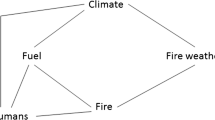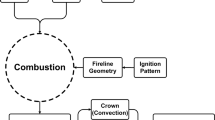Abstract
Vegetation often fuels fires. We describe both vegetation fuels and how fires burn with specific terms central to understanding fire science and management. Fuel type, amount (load), and structure mediate both the effects of fire on ecosystems and human impacts on fires. Independent of its biological nature, characterizing how readily vegetation could burn as fuels is required to describe and model fire behavior and fire effects for multiple fire science and management applications. Fire behavior terms apply to either flaming and smoldering combustion, except when preceded by a qualifier. Our book, Fire Science: From Chemistry to Landscape Management, offers a logical progression of combustion to vegetation dynamics. In this and other chapters, visually compelling examples bring key concepts to life. This chapter builds on the previous chapters focused on the chemistry of ignition and combustion, and sets up the following chapters on fire effects on people and ecosystems, then managing fuels and fires in a dynamic and changing world.
Access this chapter
Tax calculation will be finalised at checkout
Purchases are for personal use only
Similar content being viewed by others
References
Albini, F. A. (1976). Estimating wildfire behavior and effects (Gen Tech Rep INT-30). Ogden: USDA Forest Service Intermountain For Range Experiment Station.
Alexander, M. E. (1982). Calculating and interpreting forest fire intensities. Canadian Journal of Botany, 60, 349–357.
Alexander, M. E., & Cruz, M. G. (2012). Interdependencies between flame length and fireline intensity in predicting crown fire initiation and crown scorch height. International Journal of Wildland Fire, 21, 95–113.
Anderson, H. E. (1982). Aids to determining fuel models for estimating fire behavior (Gen Tech Rep INT-GTR-122). Ogden: USDA Forest Service, Intermountain Forest and Range Experiment Station.
Andrews, P. L. (2018). The Rothermel surface fire spread model and associated developments: A comprehensive explanation (Gen Tech Rep RMRS-GTR-371). Fort Collins, CO: USDA Forest Service, Rocky Mountain Research Station.
Ascoli, D., Vacchiano, G., Mott, R., & Bovio, G. (2015). Building Rothermel fire behaviour fuel models by genetic algorithm optimisation. International Journal of Wildland Fire, 24, 317–328.
Brose, P. H. (2009). Photo guide for estimating fuel loading and fire behavior in mixed-oak forests of the Mid-Atlantic Region (Gen Tech Rep NRS-45). Newtown Square: USDA Forest Service Northern Research Station.
Brown, J. K. (1971). A planar intersect method for sampling fuel volume and surface area. Forest Science, 17, 96–102.
Byram, G. M. (1959). Combustion of forest fuels. In K. Davis (Ed.), Forest fire: Control and use. New York: McGraw-Hill.
Catchpole, W. R., & Wheeler, C. J. (1992). Estimating plant biomass: A review of techniques. Australian Journal of Ecology, 17, 121–131.
Catchpole, E. A., Catchpole, W. R., & Rothermel, R. C. (1993). Fire behavior experiments in mixed fuel complexes. International Journal of Wildland Fire, 3, 45–57.
Catchpole, W. R., Catchpole, E. A., Butler, B. W., Rothermel, R. C., Morris, G. A., & Latham, D. J. (1998). Rate of spread of free-burning fires in woody fuels in a wind tunnel. Combustion Science and Technology, 131, 1–37.
Cheney, N. P. (1981). Fire behaviour. In A. M. Gill, R. H. Groves, & I. R. Noble (Eds.), Fire and the Australian Biota (pp. 151–175). Canberra: Australian Academy of Science.
Cheney, N. P. (1990). Quantifying bushfires. Mathematical and Computer Modelling, 13, 9–15.
Countryman, C. M., & Philpot, C. W. (1970). Physical characteristics of chamise as a wildland fuel (Res Pap PSW-66). Berkeley: USDA Forest Service Pacific Southwest Rocky Mountain Research Station.
Cruz, M. G., & Alexander, M. E. (2010). Assessing crown fire potential in coniferous forests of western North America: A critique of current approaches and recent simulation studies. International Journal of Wildland Fire, 19, 377–398.
Cruz, M. G., & Fernandes, P. M. (2008). Development of fuel models for fire behaviour prediction in maritime pine (Pinus pinaster Ait.) stands. International Journal of Wildland Fire, 17, 194–204.
Cruz, M. G., Alexander, M. E., & Wakimoto, R. H. (2004). Modeling the likelihood of crown fire occurrence in conifer forest stands. Forest Science, 50, 640–658.
Cruz, M. G., Gould, J. S., Alexander, M. E., Sullivan, A. L., McCaw, W. L., & Matthews, S. (2015). Empirical-based models for predicting head-fire rate of spread in Australian fuel types. Australian Forestry, 78, 118–158.
Forestry Canada Fire Danger Group. (1992). Development and structure of the Canadian Forest Fire Behavior Prediction System (Inf Rep ST-X-3). Ottawa: For Canada.
Gould, J. S., McCaw, W. L., Cheney, N. P., Ellis, P. E., & Matthews, S. (2007). Field guide-fuel assessment and fire behaviour prediction in dry eucalypt forest. Ensis-CSIRO. In Canberra. Perth: ACT and Department of Environment and Conservation.
Harris, S., Anderson, W., Kilinc, M., & Fogarty, L. (2012). The relationship between fire behaviour measures and community loss: An exploratory analysis for developing a bushfire severity scale. Natural Hazards, 63, 391–415.
Hartford, R. A., & Frandsen, W. H. (1992). When it’s hot, it’s hot ... or maybe it’s not! (surface flaming may not portend extensive soil heating). International Journal of Wildland Fire, 2, 139–144.
Hirsch, K. G., & Martell, D. L. (1996). A review of initial attack fire crew productivity and effectiveness. International Journal of Wildland Fire, 6, 199–215.
Hough, W. A., & Albini, F. A. (1978). Predicting fire behavior in palmetto-gallberry fuel complexes. Research Paper SE-RP-174. Asheville, NC: USDA Forest Service, Southeastern Forest Experiment Station, 48 p.
Keane, R. (2015). Wildland fuel fundamentals and applications. Cham: Springer.
Keane, R. E., & Dickinson, L. J. (2007). The photoload sampling technique: Estimating surface fuel loadings from downward-looking photographs of synthetic fuelbeds (Gen Tech Rep RMRS-GTR-190). Fort Collins: USDA Forest Service Rocky Mountain Research Station.
Michaletz, S. T., & Johnson, E. A. (2006). A heat transfer model of crown scorch in forest fires. Canadian Journal of Forest Research, 36, 2839–2851.
Nelson, R. M., Jr., & Adkins, C. W. (1986). Flame characteristics of wind-driven surface fires. Canadian Journal of Forest Research, 16, 1293–1300.
Pyne, S. J., Andrews, P. L., & Laven, R. D. (1996). Introduction to wildland fire (2nd ed.). New York: Wiley.
Rossa, C., & Fernandes, P. M. (2018). Empirical modelling of fire spread rate in no-wind and no-slope conditions. Forest Science, 64, 358–370.
Rothermel, R. C. (1972). A mathematical model for predicting fire spread in wildland fuels (Res Pap INT-115). Ogden: USDA Forest Service Intermountain Rocky Mountain Research Station.
Rothermel, R. C. (1991). Predicting behavior and size of crown fires in the Northern Rocky Mountains. Research Paper INT-438. USDA Forest Service, Intermountain Research Station, Ogden, UT. 46 p.
Rothermel, R. C., & Anderson, H. E. (1966). Fire spread characteristics determined in the laboratory (Res Pap INT-30). Ogden: USDA Forest Service Intermountain Rocky Mountain Research Station.
Scott, J. H., & Burgan, R. E. (2005). Standard fire behavior fuel models: A comprehensive set for use with Rothermel’s surface fire spread model (Gen Tech Rep RMRS-GTR-153). Fort Collins: USDA Forest Service Rocky Mountain Research Station.
Thomas, P. H. (1963). The size of flames from natural fires. Symposium (International) on Combustion, 9, 844–859.
Van Wagner, C. E. (1968). The line intersect method in forest fuel sampling. Forest Science, 14, 20–26.
Van Wagner, C. E. (1973). Height of crown scorch in forest fires. Canadian Journal of Forest Research, 3, 373–378.
Van Wagner, C. V. (1977). Conditions for the start and spread of crown fire. Canadian Journal of Forest Research, 7(1), 23–34.
Wooster, M. J., Zhukov, B., & Oertel, D. (2003). Fire radiative energy for quantitative study of biomass burning: Derivation from the BIRD experimental satellite and comparison to MODIS fire products. Remote Sensing of Environment, 86, 83–107.
Author information
Authors and Affiliations
Rights and permissions
Copyright information
© 2021 Springer Nature Switzerland AG
About this chapter
Cite this chapter
Castro Rego, F., Morgan, P., Fernandes, P., Hoffman, C. (2021). Fuel and Fire Behavior Description. In: Fire Science. Springer Textbooks in Earth Sciences, Geography and Environment. Springer, Cham. https://doi.org/10.1007/978-3-030-69815-7_6
Download citation
DOI: https://doi.org/10.1007/978-3-030-69815-7_6
Published:
Publisher Name: Springer, Cham
Print ISBN: 978-3-030-69814-0
Online ISBN: 978-3-030-69815-7
eBook Packages: Earth and Environmental ScienceEarth and Environmental Science (R0)




